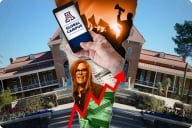You have /5 articles left.
Sign up for a free account or log in.
Faculty members and staffers at Northwestern and Washington State Universities, after more than a year of surveys, pilots and presentations, wanted roughly the same services and quality from their new learning management systems. Yet last month, they decisively chose different software providers.
Northwestern will move to Instructure’s Canvas; Washington State to Blackboard Learn. Both will leave older Blackboard products, and at both institutions, ease of use, file management and grading ranked as three key features of a new learning management system.
But as the cases at Northwestern and Washington State show, the deciding factor may not always be a feature.
“When you’re looking at the learning management systems and comparing them, their feature sets overlap by about 85 percent,” said Gregory J. Crouch, clinical associate professor of chemistry at Washington State University at Pullman. “I don’t care how they’re the same -- tell me how they’re different.”
Despite the software providers’ attempts to outperform one another on features, many faculty members still see a perfectly usable learning management system as one where they can deposit their syllabuses at the beginning of the semester and grades at the end -- and not pay much attention in between those events.
"I don’t really care about learning management systems,” said Mitchell A. Petersen, the Glen Vasel professor of finance at Northwestern. “The less time I need to spend with the system, the better off I am. If I need to think about it, that’s a problem.”
That “whatever works” attitude was reflected in a survey conducted in October 2012, when faculty at Northwestern identified a need to review the learning management system market. To the surprise of those behind the initiative, about two-thirds of faculty members said they were satisfied with the Blackboard system, deployed on campus in 1999. But tucked away in the responses were signs that “it was clear people were looking for a more modern system,” said Victoria Getis, manager of faculty support services.
After months of tinkering with the latest offerings from Blackboard, Instructure and Desire2Learn -- followed by two quarters of pilot courses on Instructure’s Canvas platform -- faculty opinion flipped. Of the 44 faculty members who responded to a post-pilot survey, 36 said they preferred Canvas, while only two preferred to remain with Blackboard. Results among students were similarly skewed: Almost 400 of the 502 surveyed said they supported a switch.
As faculty were asked to compare Canvas to an older version of Blackboard’s platform, the numbers may not come as a surprise. But even with the availability of sandboxed versions of the latest software from the three companies, the university “really didn’t get much positive movement toward either Desire2Learn or Blackboard,” Getis said.
Northwestern is part of a broader trend in the learning management system market, where institutions embark on years-long transitions to replace software more than a decade old. The end of those transitions, they hope, will bring not just savings on computer hardware -- the new systems are hosted in the cloud -- but also the flexibility to access it from a variety of devices and connect it to other web apps. When Northwestern finally powers off its old system in August 2015, it will have been almost three years since the university began the painstaking process.
“You don’t want to be locked into the new thing as opposed to being locked into the old thing, because the new thing is going to be old in five years,” Petersen said.
Two years ago, Washington State also looked poised to switch to Canvas. In May 2012, the 34 public institutions governed by the Washington State Board for Community and Technical Colleges announced it would replace its aging Angel Learning system, owned by Blackboard, with Canvas. Crouch said the board tends to set the tone for universities in the state, but that faculty at Washington State wanted to complete their own review of the software they would be dealing with for the foreseeable future.
“Canvas is the new shiny thing -- it really is,” Crouch said. "As the committee goes, we’re fairly mystified as to why Canvas is gaining the traction."
By some estimates, Blackboard’s share of the learning management system market has fallen 30 percentage points in the last six and a half years. Blackboard has responded by expanding abroad, investing in open-source software and continuing to develop its Learn platform. It still controls nearly half the market, compared to Desire2Learn and Instructure, which both register in the teens.
After two rounds of surveys and vendor presentations, a committee of faculty, staff and students unanimously chose Blackboard Learn. As with Northwestern, Washington State’s decision was influenced by more than just feature comparisons.
While Northwestern welcomed “armies of [Instructure] people,” according to Getis, Crouch said Instructure only sent a single sales representative to Washington State. Blackboard also spent weeks on a document describing how its software differed from that of Desire2Learn and Instructure, and “bent over backwards” to assist the university during its pilot.
“I want somebody to fight!” Crouch said. “These things are not cheap -- 300 grand or something like that? ... I want people to want it! When you’re trying to buy something, you want them to work at it! [Instructure] just didn’t.”
Washington State also chose the perceived long-term security of Blackboard, a familiar force in the market, over Instructure, which is expected to go public sometime this year.
“We didn’t want to take the chance,” said Devon A. Seymour, a junior political science and French major who served as the student representative on the committee. “Blackboard is a really well-established company.”
Faculty members at Northwestern and Washington State also split on the need to customize every aspect of the learning management system -- there, Canvas is slightly more restrictive. While Crouch said the decision struck him as “odd,” faculty members at Northwestern eventually decided to let a consistent student experience trump the need for customization from top to bottom.
“Canvas clearly shut down some of the control, and I was irritated -- how dare you tell me how to set up the class?” Petersen said. “It makes it more difficult for me in a sense, but it makes it much easier for the students.... This trade-off between faculty and students -- who are you trying to make it easier for? -- is definitely a balancing act.”
And after spending several years on the transition, Getis said she hopes faculty will use the new system as more than a repository.
"I’m hoping that this is the first step to many more engaging and creative ways of using technology in the classroom and outside the classroom," Getis said. "We will be using it as a first step toward using technology to not only engage students, but also facilitate teaching and student learning."








